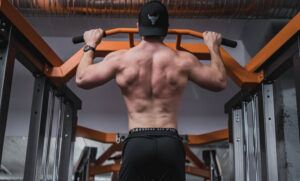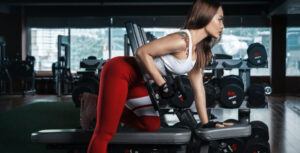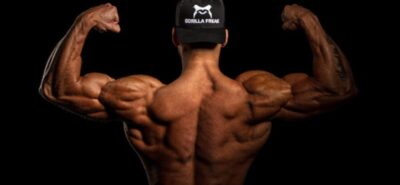A lot of beginners and intermediate bodybuilders focus in building a huge chest, jacked arms a six-pack and sometimes neglect their back muscles.
Building back muscles is essential to keep your body proportional and looking aesthetically pleasing, which makes it just as important as building muscle on the front of your body. Today I am going to tell you the best exercises for a bigger back to help you keep your body proportional and functioning to the best of its ability.
After telling, you the best back exercises for building muscle, I am going to give a workout plan identically to the plan I used to help you incorporate a mixture of compound and isolation exercises into your routine and get the best gains out of every back workout you to.
Before I dive into exercises and workout plans, I am going to give you a break down of the muscles in the back so you have a better understanding, and know the exact area of the back each exercises targets as I talk you through each exercise.
Understanding the Back Muscles
The back in made up of many muscles which all have a specific role, but not all of these muscles are visible or can be trained. There are 6 main back muscles that we target when working out, which I will tell you about today.
Latissimus dorsi
Your latissimus dorsi, which are commonly known as the ‘lats’ are the largest individual muscles in your upper back, that run down the sides of your torso and, when developed through resistance training, give you the ‘ V taper’ look. Your last are involved in almost all compound exercises for back as they are the largest and strongest muscle.
Rhomboids
Your rhomboids are below your traps and work synergistically with them. They contract hard to lock your shoulder blade in position, allowing other muscles to contract, and also work closely with other muscles in your back to help stabilize your shoulders.
Trapezius
The trapezius muscles are located between your shoulders and your neck, which are noticed more by looking at the front of you body. However, they actually reach all the way down to the lower back.
Posterior Deltoids
The posterior deltoids are located at the back of your shoulder, which are connected to the flat surface of your shoulder blade, and are what helps your arm move backwards.
Rotator Cuff
The rotator cuff is a group of muscles and tendons that surround the shoulder joint, and help keep the upper arm bone in the socket of the shoulder.
Erector Spinae
The erector spine is a deep back muscle which it appears front a tendon attached to the crest, along the centre of the sacrum.
Compound vs Isolation Exercises
All exercises can be broken down into 2 groups, they are either compound exercises or isolation exercise. It is important to know the different between them, as you can incorporate certain exercises into your workout depending on your training goals.
Compound exercises are exercises that work multiple muscle groups at the same time, which makes them great exercises for building strength and muscle mass.
They are also very convenient, as by working multiple muscles at once, it can save you a lot of time when working out, whilst at the same time burning a lot more calories than isolation exercises, as they activate more muscle cells.
Isolation exercises are important exercises when correcting muscle imbalances as they directly target and strengthen a certain muscle.
As they target certain muscles it also makes them very useful to target a certain muscle, if you feel like a certain part of your body is falling behind the rest of your body.
Both compound and isolation exercises are very important exercises in a workout routine, and if you want to build a nice physique, a balance of both compound and isolation exercises is essential.
Best Compound Exercises for Building a Strong Back
Compound exercises use multiple muscles at the same time to perform the movement, making them extremely good for building strength and gaining muscles in your back.
Here are the best compound back exercises that will maximize your muscle growth.
1. Bent-Over Row
The bent-over row is in my opinion, the best compound back exercise by far to build strength and muscle mass, due to the large amount of muscles used when performing the exercise.
The primary muscles used are.
- Latissimus Dorsi
- Middle Trapezius
- Lower Trapezius
- Rhomboids
- Posterior Deltoids
The secondary muscles used are.
- Lower Back
- Biceps
- Forearms
- Rotator Cuff
How to perform bent-over…
- Stand with feet shoulder width apart and your knees slightly bent.
- Grab a barbell with an overhand grip, hands just wider than shoulder width apart.
- Keeping your back straight, lock your core and bend over at the waist until your torso is almost perpendicular to the floor.
- Row the weight upwards towards your hips, keeping your elbows close to your body.
- Slowly lower the weight, returning to the starting position.
Bent-over rows are an easy to perform and adaptable exercise, as you can row a barbell, dumbbells or a kettle bell.
2. Wide-Grip Pull-Up
 The wide grip pull-up is a perfect compound exercise for building back muscle, as you use a lot of cores and pure strength to raise yourself up to the bar.
The wide grip pull-up is a perfect compound exercise for building back muscle, as you use a lot of cores and pure strength to raise yourself up to the bar.
The primary muscles used are.
- Latissimus Dorsi
- Biceps
The secondary muscles used are.
- Shoulders
- Core
- Forearms
How to perform wide-grip pull-up…
- Grab the bar with an overhand grip, with your arms straight and about a meter apart.
- Pull yourself straight up, until your chest is at the bar.
- Lower yourself back down in a controlled motion, back to starting position.
When targeting muscle growth in your back and biceps it is important to perform this movement with strength and control, not momentum. Make sure to avoid using momentum to carry you through the movement as this will take tension off your back and bicep muscles.
3. Deadlift
The deadlift is a very popular compound exercise used in bodybuilding, that is an amazing strength-training exercise and offers many benefits for different health and fitness goals.
The primary muscles used are:
- Lower Back
- Hamstrings
- Core
- Glutes
- Trapezius
The secondary muscles used are:
- Latissimus Dorsi
- Rhomboids
- Calves
- Abdominal
How to perform dead lift…
- Stand with your feet hip-width apart and your toes under the bar.
- Bend over and grab the bar with an overhand grip about shoulder-width grip apart.
- Bend your knees until your shins touch the bar and lift your chest up.
- Drive through the floor with the legs, keeping the bar against the body, to lift the weight off the floor.
- Lower the bar to the floor in the reversing motion.
The deadlift is a key of most strength-training programs, and is one of the three lifts performed in the sport of power lifting. It is very important to use a good deadlift technique with a braced, neutral spine to prevent the risk of injury.
4. Single Arm Row
The single-arm dumbbell row is another popular compound back exercise. It is a strength training exercise that can help gain strength, boost hypertrophy, and build the thickness of your back.
The primary muscles used are.
- Latissimus dorsi
- Rhomboids
- Trapezius
- Rear Deltoids
The secondary muscles used are…
- Core
- Biceps
- Lower Back
- Forearms
- Rotator Cuff
How to perform single-arm row…
- Place a dumbbell on the floor on the right side of a flat bench.
- Stand with your left knee on the end of the flat bench and plant your left hand on the bench so that it is directly under your shoulder.
- Bend down and grab the dumbbell in your right hand with your palms facing inwards, your shoulders in line and your back straight and parallel to the floor.
- Pull your right arm up until your elbow is pointing to the ceiling, your upper arm is parallel to the floor, and your hand comes to the outside of the rib cage.
- Slowly lower weight, returning to starting position.
When performing the single arm row it is important that you pull front your back muscles, not just lifting your arm up and down, to ensure that your back gets the full effect on the exercise.
5. T-bar Row
T-bar rows are a useful compound exercise for back, as it allows you to lift heavy with high reps, and work a large amount of muscle groups at once.
The primary muscles used are.
- Latissimus Dorsi
- Rhomboids
- Rear Deltoids
- Trazezius
- Teres Major
The secondary muscles used are.
- Biceps
- Triceps
- Forearms
- Hamstrings
- Glutes
- Core
How to perform T-bar row…
- Stand with your feet about hip-width apart, grab the handles of the T-bar, with your arms fully extended and your back straight.
- Lift the weight off the ground, letting it hang in front of your body.
- Slowly pull the weight towards your chest by retracting your shoulder blades and squeezing your back muscles, making sure you keep your elbows close to your body.
- Pause at the top of the movement for a second, then slowly lower the weight.
T-bar rows are a simpler exercise than most other compound back exercises, as the machine guides the weight, and getting into your starting position is much easier. Despite being easy to learn, technique is still important as it is with all exercises.
6. Wide Grip Lat Pull Down
As you can probably guess front the name of the exercise, the lat pulldown targets the latissimus dorsi, which is a muscle located at the top of your back and more commonly referred to as the ‘lats’.
The primary muscles used are.
- Latissimus Dorsi
The secondary muscles used are.
- Deltoids
- Biceps
- Lower Back
- Middle Back
- Trapezius
- Forearms
How to perform lat pulldown…
- Adjust the thigh pad to a comfortable position so that the weight won’t lift you off the seat.
- Sit with your thighs under the thigh pad, keep your chest up, and look at the bar.
- Grab the bar with an overhand grip and your hands slightly wider than shoulder-width apart.
- Pull the bar down towards your chest, until it lightly touches your upper chest.
- Squeeze your shoulder blades together at the bottom of the movement and then slowly release the bar back to starting the position.
Over the years I have seen many people perform lat pulldowns behind the neck, which you have probably seen aswel. This is not a good technique and could lead to injuries, due to the rotation of the shoulder joint.
7. V Handle Lat Pulldown
The primary muscles used are.
- Latissimus Dorsi
The secondary muscles used are.
- Deltoids
- Biceps
- Lower Back
- Middle Back
- Trapezius
- Forearms
How to perform neutral grip pulldown…
- Adjust the thigh pad to a comfortable position so that the weight won’t lift you off the seat.
- Sit with your thighs under the thigh pad, lean back slightly and look at the handle.
- Grab the handle and pull it down towards your chest, until it lightly touches your lower chest.
- Squeeze your shoulder blades together at the bottom of the movement and then slowly release the handle back to starting the position.
Applying Definition Through Isolation Exercises
Isolation exercises can help target specific muscles in your back and develop better muscle definition. Finishing off a back workout with one or two isolation exercises maximizing muscle.
Here are some of the best isolation exercises to help define your back.
1. Rear Delt (back) Fly Machine
The rear delt machine is an exercise that targets the rear deltoids, as well as the muscles of the upper back. It is the reverse of the chest fly machine, and can be performed on the same machine, but facing the opposite direction.
How to perform rear delt fly machine…
- Adjust the handles so that they are fully to the rear and adjust the seat height so the handles are at shoulder level.
- Grab the handles with your hands facing inwards, and your arms slightly bent.
- Pull your hands out to your side and back, contracting your rear deltoids.
- Pause at the back of the movement, and slowly return arms to the starting position.
The rear deltoids fly machine is a very simple and easy exercise to learn. It is a great exercise to add size and strength to the rear deltoids, rhomboids and the trapezius muscles.
2. Straight Arm Lat Pulldown (Cable)
Cable straight arm pulldowns are an amazing isolation exercise to promote back size and width, which primary targets the latissimus dorsi muscle.
How to perform straight arm lat pulldown (cable)…
- Grab the cable with an overhand grip about shoulder-width apart, with elbows locked and arms straight.
- Breathe out while pulling the cable down to your thighs in a smooth, controlled motion, arms remaining straight, hips bending slightly forward while keeping the back straight.
- Pause for a second when the hand grips are at thigh level, then return to full arm extension above your head.
The triceps, pectoralis major, wrist flexors, and the abdominal muscles are muscles that work to stabilize the move. Learning to engage your abs when pulling the cable will help you develop core stability.
3. Rope Straight Arm Pulldown
Straight arm lat pulldowns with a rope are identical to the straight bar version, apart front the obvious difference that you are using a rope attachment instead of a straight bar.
Using the rope forces you to use slightly less weight than the straight bar, but it allows a slightly increased range of movement, as you can get an extra squeeze at the bottom of the movement, making them an excellent isolation exercise for back muscles.
You should experiment with both versions to see what feels more natural. Some people prefer using a straight bar; others find the rope more beneficial for training the back.
Creating a Balanced Back Workout Plan
Here is a back workout plan that I am currently using myself, and have used many times before to increase back strength and muscle mass. It contains a combination of 3 compound exercises and 2 isolation exercises to maximize muscle growth.
For compound exercises you should aim for 6-8 rep range, to increase strength and muscle mass and for isolation exercises you should aim for 10-12 rep range, to increase muscle hypertrophy.
| Exercise | Sets | Repetitions | Targeted Muscles |
|---|---|---|---|
| Bent Over Row | 4 | 6-8 reps | Upper Back, Lats, Biceps |
| Lat Pull Down | 4 | 6-8 reps | Lats, Biceps |
| T-Bar Row | 4 | 6-8 reps | Upper Back, Lats, Biceps |
| Reverse Fly | 4 | 10-12 reps | Rear Deltoids, Upper Back |
| Reverse Fly Cable | 4 | 10-12 reps | Rear Deltoids, Upper Back |
It is important to perform each exercise with the correct front, and squeeze the back muscles for a second at the bottom of each exercise to maximize muscle hypertrophy.
Conclusion: Consistency Is Key
In conclusion, don’t underestimate the importance of developing your back muscles in your fitness journey. A well-balanced physique requires attention to both front and rear muscle groups. Understanding the back’s anatomy and incorporating a mix of compound and isolation exercises is essential.
Compound exercises are excellent for building overall back strength and muscle mass. Meanwhile, isolation exercises help target specific back muscles and address any imbalances.
By following a structured workout plan that combines these exercises with varying rep ranges, you can achieve a more proportionate and aesthetically pleasing back while enhancing your overall physical performance.
However, no matter what back workout you perform, it is essential to combine it with a good diet to match your training goals. There are also many supplements on the market to help you achieve a huge back.
I have written the following articles that will help you to create the perfect combination of training, dieting and supplementation, to ensure you get best gains you can achieve.
- Fueling Your Gains: The Ultimate Guide to Nutrition for Lean Muscle Building
- Top supplements for building lean muscle.
- Benefits and Side Effects of Creatine Monohydrate.
Now it is time to hit the gym to try out some new back exercises and watch your back transform into the huge back that you desire.
Feel free to leave any questions or comments below, and share this article with others who share your passion for bodybuilding. Stay dedicated, and you will see the results you desire.
